AI | Feb 21, 2025 | 7 min read | By Rahul Khinchi

Rahul Khinchi is a Developer Advocate at Treblle, where he focuses on improving API workflows and developer experience. He writes technical content on API observability, security, and governance, and builds open-source tools to demonstrate real-world API use cases. Rahul has spoken at developer meetups and universities, and previously held developer advocacy roles at Syncloop. He was selected for Google Summer of Code in 2022 and has led community initiatives supporting thousands of beginners in open source.
You’ve built an API. It works. It solves a problem. But without the right AI API assistant, getting developers to adopt it can be frustrating—endless support tickets, debugging repetitive errors, and outdated documentation.
Think about the last time you onboarded someone to your API.
These aren’t hypotheticals. They’re daily realities when APIs grow beyond a few endpoints.
Tools like Alfred AI and Postbot solve these issues by improving API workflows at different stages. Alfred AI helps developers integrate APIs faster by turning documentation into actionable code and reducing support tickets. Postbot focuses on internal development by generating tests, debugging issues, and documenting endpoints.
Want smarter, AI-powered API docs that guide developers instantly?
Alfred adds an AI assistant to your docs so devs get answers in seconds.
Explore Treblle
Want smarter, AI-powered API docs that guide developers instantly?
Alfred adds an AI assistant to your docs so devs get answers in seconds.
Explore Treblle
The catch? Choosing the wrong tool for your needs means sacrificing efficiency gains.
In this blog, we’ll learn:
Alfred AI and Postbot aim to improve your API workflows but solve different problems.
Alfred AI by Treblle focuses on improving API adoption for your customers. It uses your API documentation to answer questions, generate integration code, and reduce support overhead.
Think of it as a “developer advocate” embedded directly into your API portal.
For instance, Alfred AI provides an answer based on your current documentation if you need a sample integration code for a new shipment-tracking endpoint. This assistant reduces the need for manual updates and decreases support requests, allowing you to focus on your application's business logic.
You have several ways to add Alfred AI to your workflow:
Insert a script into your HTML before the closing </body> tag:
<script src="https://assets.treblle.com/alfred-embed-v5.min.js"></script>Add this JS integration code directly on your developer portal to enable Alfred AI.
<div class="getalfred-io"data-api="_YOUR_TREBLLE_PROJECT_ID_" data-auth="_YOUR_CUSTOMER_API_KEY_" ></div>Find _YOUR_TREBLLE_PROJECT_ID_ and _YOUR_CUSTOMER_API_KEY_ in your Treblle dashboard under API Settings > Credentials.
When you ask Alfred for a code example, it picks up the endpoint, method, and language you need. This/auth/register example uses axios in Node.js includes error handling and explains how to set it up.
Need a different endpoint or framework? Just ask, and it’ll show you how.
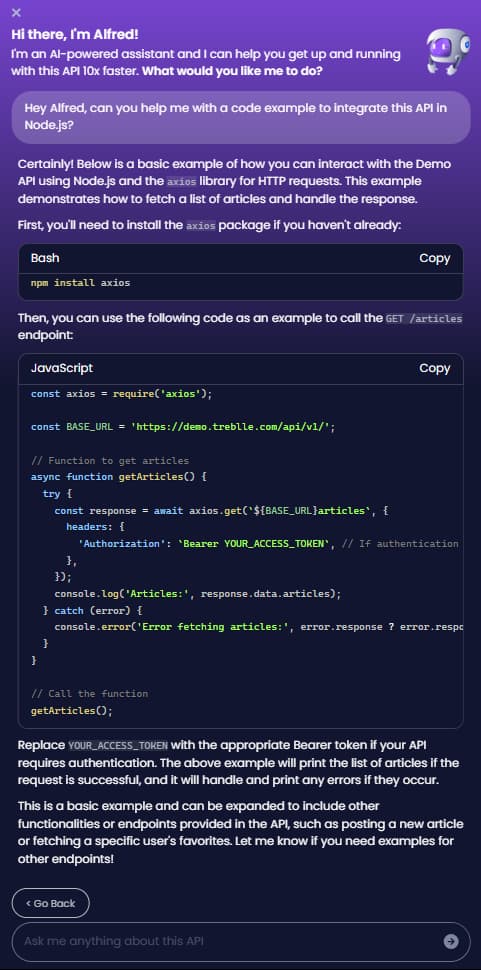
Alfred inspects your API’s schema and generates realistic mock payloads for webhook events. It ensures the data follows the expected format, helping you test integrations without waiting for actual events.
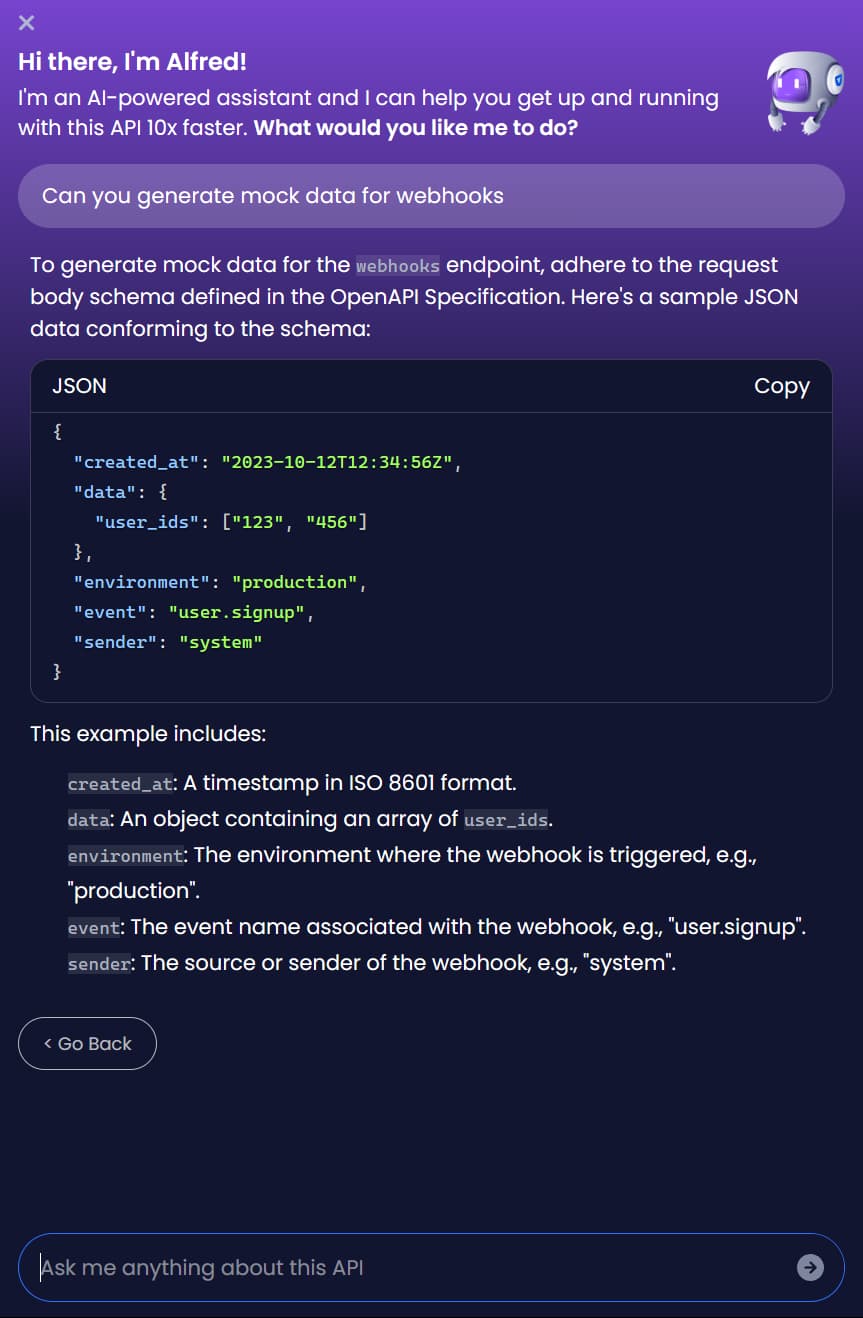
Postbot by Postman targets accelerating API development and testing. It automates tasks like writing test scripts, generating documentation, and debugging requests.
It’s a coding companion inside Postman’s ecosystem.
When you need to create a test script for an endpoint or visualize the data returned by a request, Postbot provides inline suggestions to guide you through the process. It also helps in debugging by identifying issues and resending requests when necessary.
Postbot taps into your existing Postman workspace:
{{base_url}} or {{api_key}}? Postbot autocompletes variables from your active environment.Postbot continuously monitors your API collections. As you add or modify endpoints, its suggestions update accordingly. This feature assists you in maintaining a consistent testing and documentation workflow without manually tracking changes.
Postbot scans your API collection for endpoints with rate limits. It generates a test script using Postman’s pm.response syntax:
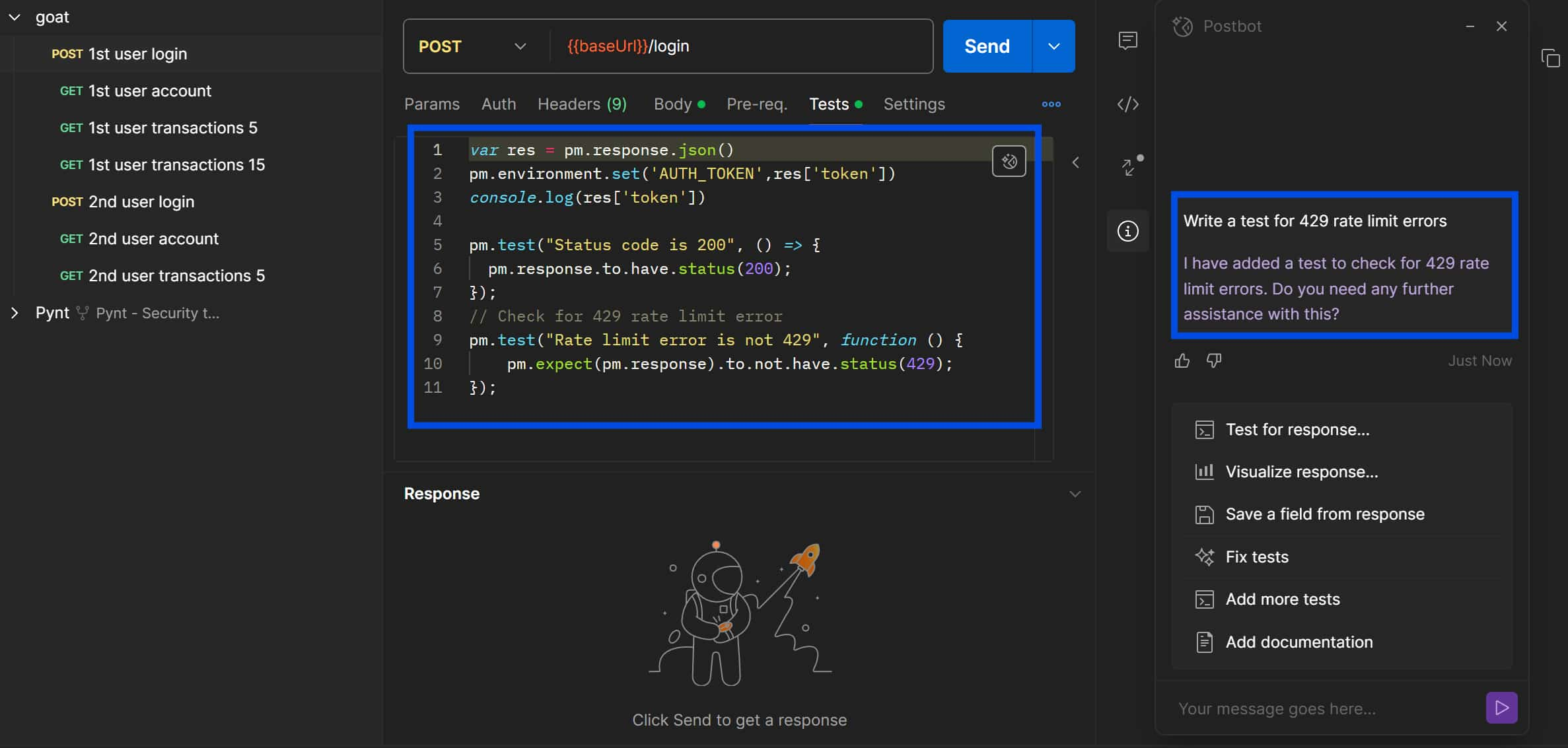
Postbot checks the failed request’s headers, body, and URL against your API’s past successful calls.
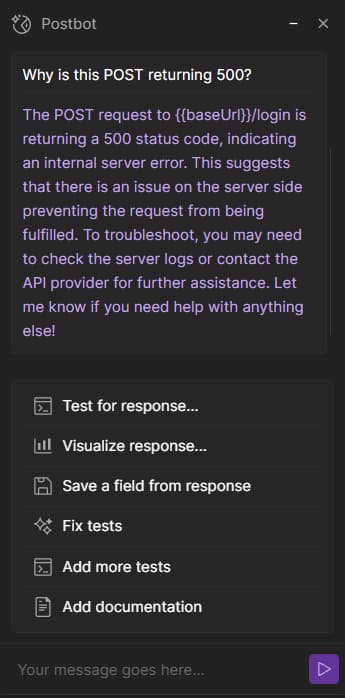
| Aspect | Alfred AI | Postbot |
|---|---|---|
| Data Source | Uses live API traffic and OpenAPI specs. | Leverages Postman collections and variables. |
| Audience | External developers integrating your API. | Internal developers working on API development. |
| Customization | Limited to answers from API documentation. | Learns from Postman usage patterns. |
Want smarter, AI-powered API docs that guide developers instantly?
Alfred adds an AI assistant to your docs so devs get answers in seconds.
Explore Treblle
Want smarter, AI-powered API docs that guide developers instantly?
Alfred adds an AI assistant to your docs so devs get answers in seconds.
Explore Treblle
Let’s examine how each tool handles everyday API tasks:
| Feature | Alfred AI (Treblle) | Postbot (Postman) |
|---|---|---|
| Generating Integration Code | Uses your API docs to create SDKs, code snippets, and data models for customers. | Generates test scripts, collection code, and mock servers for internal use. |
| Debugging | Explains API errors using your docs (e.g., “Why is this 403 occurring?”). | Identifies issues in requests/responses and resends corrected calls. |
| Documentation | Auto-updates based on live API traffic or uploaded OpenAPI specs. | Creates docs from scratch or refines existing ones via natural language. |
| Authentication Help | Guides customers through OAuth, API keys, or JWT flows specific to your API. | Assists with auth setup in Postman (e.g., generating tokens). |
| Data Visualization | N/A | Converts JSON responses into tables, charts, or graphs. |
| Embeddability | Integrates into developer portals via a script. | Works only within Postman’s desktop/app interface. |
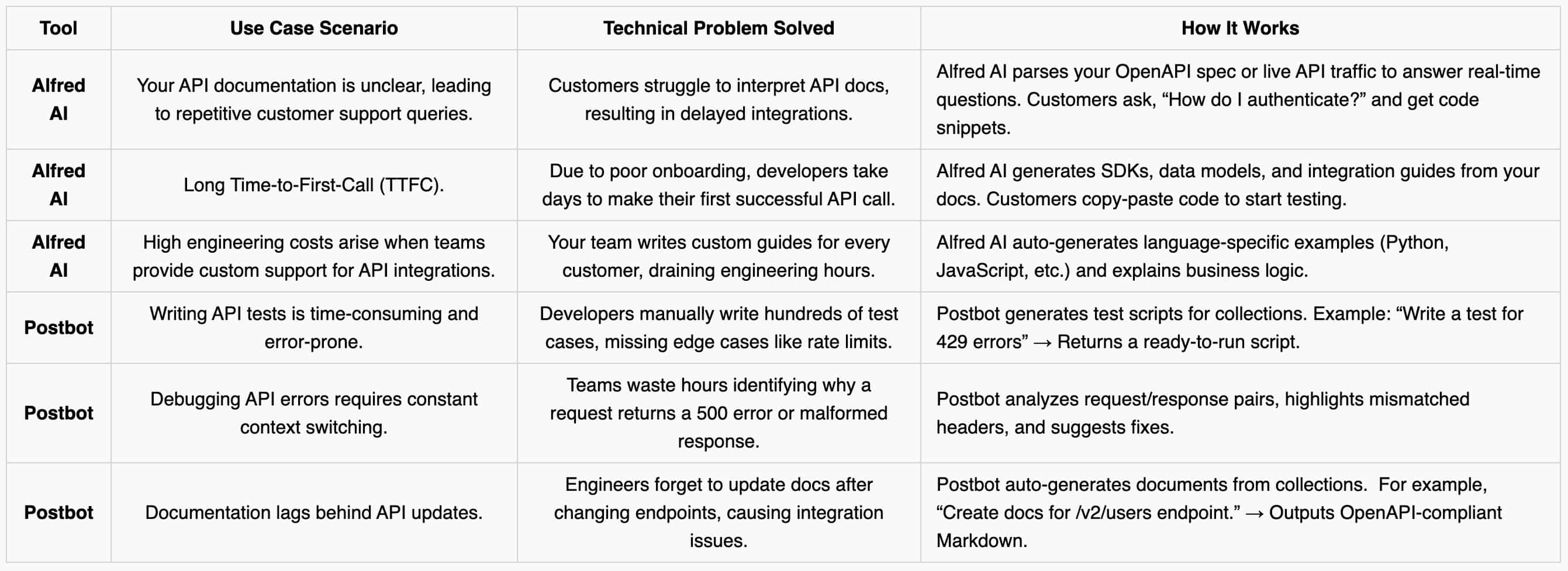
Alfred AI and Postbot aren’t direct competitors, but they solve different problems.
Combining both tools for teams building and maintaining APIs could eliminate 60-80% of repetitive work.
Start by identifying your problem: customer onboarding or internal development.
Want smarter, AI-powered API docs that guide developers instantly?
Alfred adds an AI assistant to your docs so devs get answers in seconds.
Explore Treblle
Want smarter, AI-powered API docs that guide developers instantly?
Alfred adds an AI assistant to your docs so devs get answers in seconds.
Explore Treblle
 AI
AIReducing Time to First Integration is more than speed; it’s a key metric. In this post, discover 6 proven methods, backed by AI and observability, to simplify onboarding, cut friction, and lower integration time without sacrificing reliability.
 AI
AIModern APIs are powerful but difficult to integrate. Poor documentation, fragile code, and tool sprawl slow teams down. This article explores how AI is transforming API integration—automating onboarding, testing, and governance to boost speed, reliability, and scale.
 AI
AILLMs are calling your APIs, but they don’t always follow the rules. From subtle JSON mismatches to silent data pollution, probabilistic outputs can quietly break your backend. Here’s why contracts matter, and how to enforce them in real time.